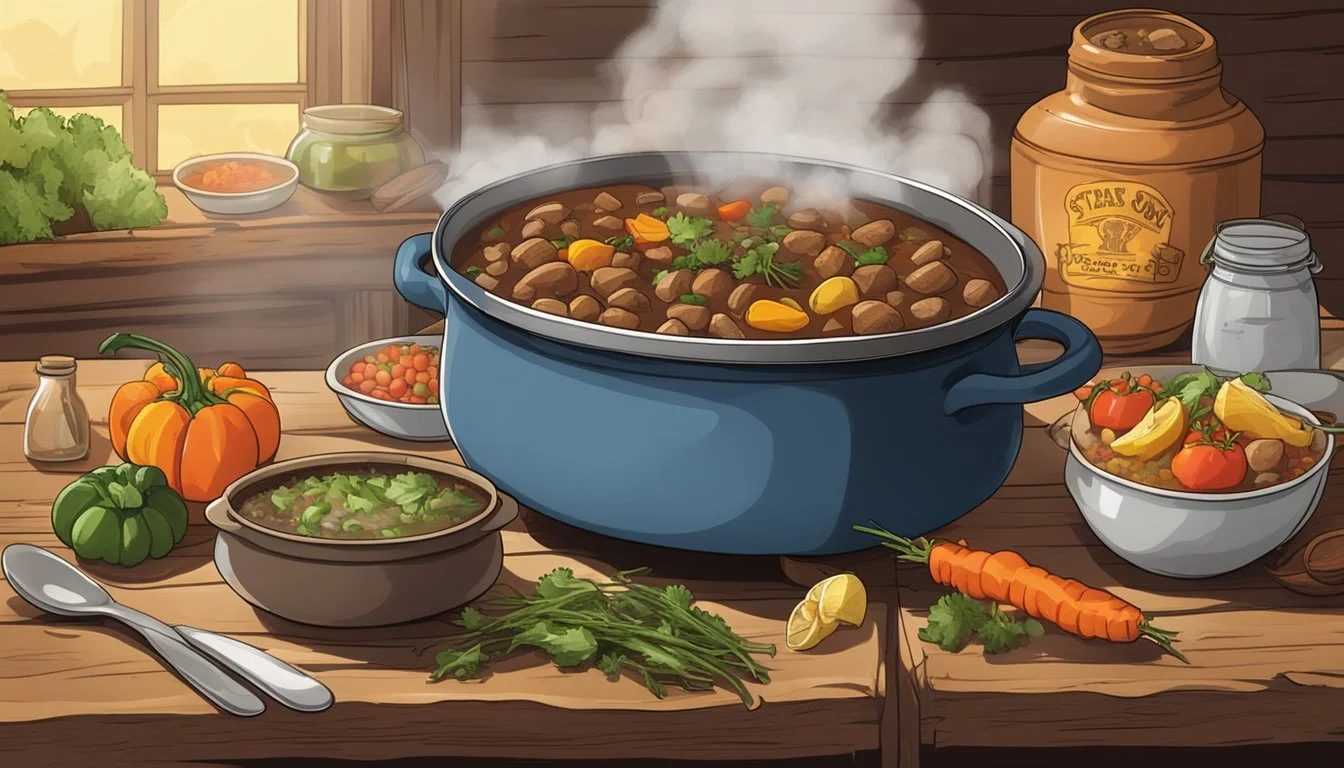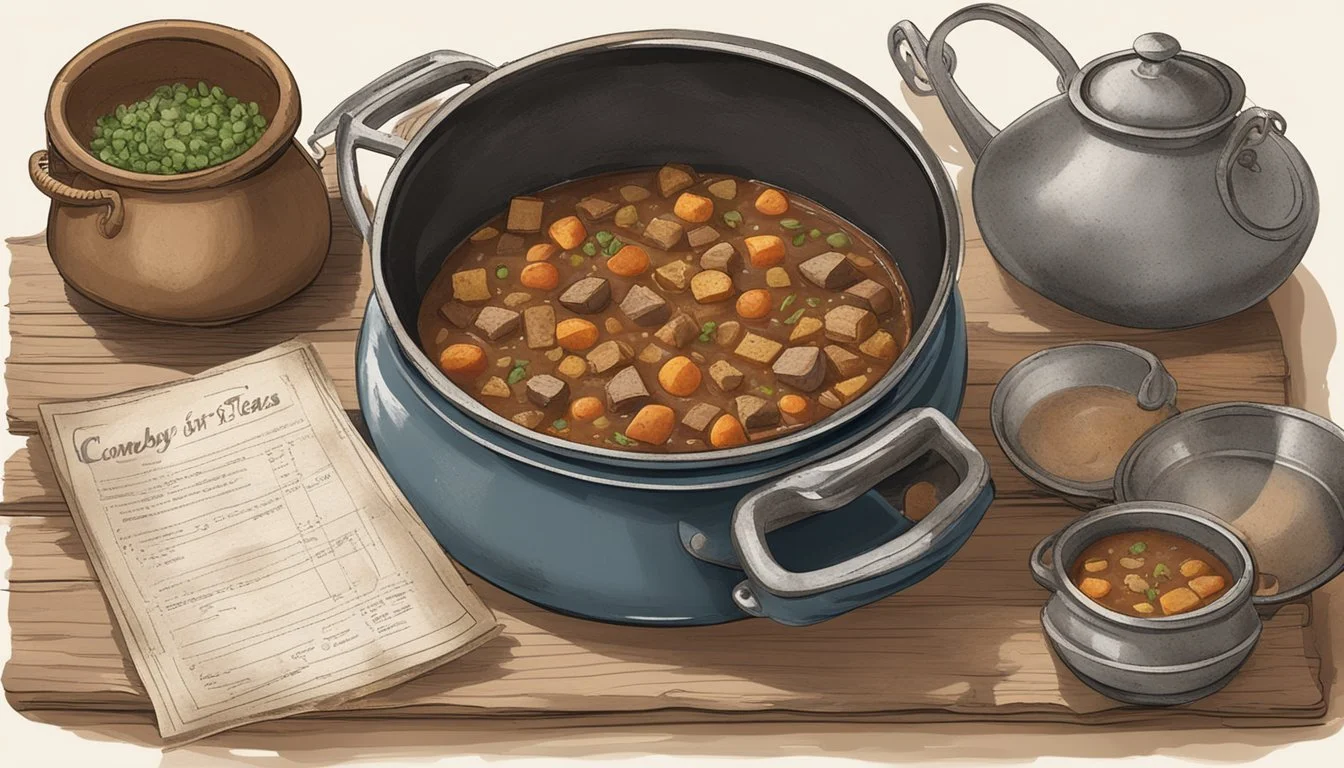The Secret Ingredients of Texas Cowboy Stew
Unveiling Tradition's Hearty Flavors
Texas Cowboy Stew stands as a testament to the state's rich culinary traditions, offering a window into its hearty heritage. This dish is more than just comfort food; it is a celebration of the cowboy culture that shaped the Lone Star State. With its robust flavors and simple preparation, the stew is a staple for those seeking both sustenance and a taste of history. The recipe's ease makes it a favored choice among home cooks aiming to bring a piece of Texas to their dinner tables.
The stew is a medley of ingredients that work together to create a comforting bowl of flavors. It's a versatile dish, allowing for variations in protein and vegetables, but always includes a base of meat, beans, and a thick, savory broth. Whether simmered on the stove or cooked in a slow cooker, the cooking process allows the flavors to meld together, resulting in a rich and filling meal.
In the spirit of Texas hospitality, Texas Cowboy Stew invites customization while staying true to its origins. Ingredients such as corn, potatoes, pinto beans, tomatoes, and a mix of spices are commonly found in recipes, reflecting the resourcefulness of cowboys on the range. This dish, hearty and satisfying, personifies the essence of Texas comfort food.
The Heritage of Texas Cowboy Stew
Texas Cowboy Stew is a testament to the resourcefulness of ranch hands of the past, encapsulating the robust history and cultural backdrop of the American Southwest with its evolution into a modern-day comfort food staple.
Historical Roots
The advent of Cowboy Stew dates back to the cattle drives of the 19th century when cowboys needed hearty and filling food that could be cooked over an open flame. As they traversed the Texan landscape, cowboys would prepare this stew using easily preserved ingredients that could withstand the rugged conditions of the trail. Key ingredients typically included whatever meat was on hand, like beef or pork, along with beans, onions, and potatoes, which provided the necessary sustenance for the physically demanding cowboy lifestyle.
Cultural Significance
In Texan culture, Cowboy Stew represents more than just a meal; it embodies a sense of camaraderie and survival. Cowboys often gathered around the campfire, sharing tales and traditions, while a communal pot of stew simmered away. It is a culinary icon that speaks to the melding of different cultures, as it includes elements from Mexican and Southern cuisines, evident in the use of spices like chili powder and cumin.
Evolution of the Recipe
Through the years, the cowboy stew recipe has evolved, with cooks adding their own regional flare. Modern recipes often call for a wider variety of vegetables and sometimes include more modern proteins such as ground beef or sausage. Availability and technology have also influenced its preparation, with today's slow cookers and crockpots offering a convenient method to achieve the traditional low and slow simmer of the stew.
Traditional Ingredients:
Beef or pork
Beans
Potatoes
Onions
Chili powder & cumin
Modern Variations:
Additional vegetables (e.g., corn, tomatoes)
Use of slow cookers for convenience
Inclusion of different meats like sausage
From the open range to the modern kitchen, Texas Cowboy Stew continues to be a hearty reflection of Texan heritage, adapting with time while staying true to the spirit of its origins.
Essential Ingredients
The essence of a hearty Texas Cowboy Stew lies in its robust selection of ingredients. Meats provide a rich base, beans add texture and protein, while vegetables contribute fresh flavors and nutrients to the dish.
Meats: Variety and Selection
Texas Cowboy Stew typically features a combination of ground beef and sausage as its meaty foundation. The ground beef should be browned and drained of excess fat to maintain a balanced flavor without being greasy. Sausage, such as smoked sausage, adds depth with its smoky notes. One can also include other proteins like chicken, turkey, or bacon to diversify the taste and texture.
Key Meats for the Stew:
Ground beef
Smoked sausage
Optional: bacon, chicken, or turkey
Beans: Types and Preparation
Pinto beans are a staple in this stew, offering heartiness and a creamy texture. They should be rinsed from the can to remove excess sodium or soaked overnight if using dried beans. One may also consider using kidney beans or a combination to add color and variety to the stew.
Preferred Beans for the Stew:
Pinto beans
Kidney beans (optional)
Vegetables: Freshness and Flavor
A mix of fresh and canned vegetables forms the backbone of this stew's flavor profile. Onion and garlic serve as aromatic bases, while potatoes and corn add substance. Include diced tomatoes with green chilies for a kick of heat and frozen mixed vegetables for convenience without compromising taste. Fresh vegetables like squash can also be incorporated for added nutrition and color.
Vegetables to Include:
Onion
Garlic
Potatoes
Corn
Tomatoes with green chilies
Frozen mixed vegetables (such as carrots, peas, and green beans)
Optional: squash
Seasonings and Spices
Texas Cowboy Stew is characterized by its bold and robust flavor profile, primarily achieved through a well-considered blend of spices and seasonings. These ingredients are not just about heat; they're about depth and character, bringing the spirit of the Southwest to each bite.
Chili Powders and Peppers
Chili powder is the cornerstone of this stew, providing a warm and smoky flavor that is quintessential to Southwestern cuisine. The powder is often a blend of ground chile peppers, cumin, and other spices, which creates a complex base for the stew's rich sauce. Variations can include ancho or chipotle powders, each contributing its own unique flavor—ancho chilies offer a mild, sweet heat, while chipotle peppers add a smoky dimension.
Common Chilies Used:
Ancho chili powder
Chipotle chili powder
Cayenne pepper (for an extra kick)
The use of green chile peppers also complements the stew with a tangy and slightly zesty edge, often desired in Texan stews (What wine goes well with stews?) for that authentic touch.
Herbs and Aromatic Spices
Aside from chili powders, a blend of aromatic spices adds layers to the stew's character. Cumin, with its earthy and slightly bitter essence, is a fundamental spice that infuses the dish with its distinct Southwest flavor. Smoked paprika brings in a subtle sweetness coupled with a smokiness that echoes the rustic origins of cowboy cuisine.
Essential Herbs and Spices:
Cumin: Earthy foundation
Smoked Paprika: Sweet, smoky overtones
Black Pepper: Sharp, pungent kick
Seasoning the stew with ample salt is essential to balance and enhance all these flavors, ensuring each spice plays its part in creating a harmonious and hearty dish.
Cooking the Perfect Stew
To achieve the quintessential Texas Cowboy Stew, one must pay attention to the cookware used, the simmering process, and the specific adjustments needed for richness and flavor.
Choosing the Right Cookware
Optimal cookware is crucial for crafting the perfect stew. A Dutch oven or a heavy-bottomed pot is preferred for even heat distribution. For those favoring modern convenience, a slow cooker can be an excellent alternative, especially for tenderizing tougher cuts of meat over several hours.
Dutch Oven: Ideal for stovetop and oven use, provides superior heat retention.
Heavy-Bottomed Pot: Prevents ingredients from sticking and burning.
Slow Cooker: Convenient for "set and forget" cooking, allowing flavors to meld over time.
Simmering Techniques
Simmering is a central step in stew-making where flavors develop and ingredients intermingle into a harmonious blend. Maintaining a gentle simmer ensures meats and vegetables cook thoroughly without disintegrating.
Maintain a consistent low heat for at least 1 hour on the stove, or longer in a slow cooker.
Stir occasionally to prevent sticking and check for even cooking.
Adjustments and Flavorings
Adjustment and seasoning are vital, allowing each cook to tailor the stew to their taste. Rich beef broth is the traditional base for Texas Cowboy Stew, although some cooks might prefer chicken broth for a lighter version.
Broth: Choose high-quality beef or chicken broth for a flavorful liquid base.
Serve with cornbread or cornbread muffins for a complementary texture that soaks up the stew's hearty sauce.
By adhering to these guidelines with care and precision, the cook prepares a one-pot meal that captures the authentic spirit of the Lone Star State—a robust Texas Cowboy Stew that is as much a feast for the palate as it is a testament to culinary heritage.
Accompaniments and Sides
The robust flavors of Texas Cowboy Stew are best complemented with sides that can soak up its hearty gravy or offer a refreshing contrast. The sides chosen can either echo the stew's southern roots or provide a lighter accompaniment to balance the meal.
Cornbread: A Southern Staple
Cornbread is the quintessential partner for any Southern stew. Its sweet, crumbly texture makes it perfect for sopping up the rich sauce of the stew. Cornbread muffins, with their individual serving size, provide a playful and convenient option for dunking.
Classic Cornbread: Baked in a skillet for a crispy edge.
Honey-infused Cornbread: Adds a touch of sweetness.
Jalapeño Cheddar Cornbread: Incorporates a spicy kick with melted cheese.
Vegetable Sides and Alternatives
While the stew itself is laden with meat and legumes, fresh vegetable sides can add a crisp contrast to the meal. A salad dressed with a light vinaigrette tackles the richness of the stew. For those preferring grains, rice serves as a subtle base that absorbs the stew’s flavors well.
Garlic bread: An aromatic alternative for those who prefer a garlicky crunch.
Steamed vegetables: Maintain nutrients and provide a clean taste.
Roasted root vegetables: Complement the earthy tones of the stew with their natural sweetness.
Storing and Reheating Tips
Proper storage and reheating of Texas Cowboy Stew are essential to maintaining its flavor and ensuring safety. The following practices are recommended to maximize the stew's quality and longevity.
Safe Storage Practices
Storing leftovers should be done promptly. Any remaining stew should be cooled to room temperature within two hours and then placed in an airtight container. Containers should be shallow to allow for quick cooling. In the refrigerator, the stew can be kept for three to four days. For longer storage, freezing is an option. To freeze the stew, one should portion it into suitable containers, label with the date, and it can be stored in the freezer for up to three months.
Refrigeration: Cool, airtight, up to 4 days
Freezing: Portion, label, up to 3 months
Reheating for Best Flavor
When reheating Cowboy Stew, the goal is to restore it to its original, hearty flavor while ensuring it is heated to a safe temperature. Stew can be reheated on the stove over medium heat, stirring occasionally, until it reaches a simmer. If using a microwave, the stew should be covered and reheated in intervals, stirring each time to promote even heating. Finally, for crockpot reheating, one should allow several hours on a low heat setting, ensuring the stew reaches the proper internal temperature of 165°F before serving.
Stovetop: Medium heat, stir, simmer
Microwave: Covered, intervals, stir
Crockpot: Low heat, several hours
Recipe Variations and Substitutions
In the realm of Texas Cowboy Stew, cooks often enjoy a great deal of flexibility with ingredients, which allows for a wide range of meat choices and the ability to cater to different dietary restrictions without sacrificing flavor.
Alternative Meat and Protein Options
For those seeking a twist on the traditional beef in their stew, substitutions such as ground turkey or chicken offer a leaner profile while still providing ample protein. Kielbasa or smoked sausage can also be incorporated to impart a deeper, smoky flavor. It's common to brown these meats beforehand to render out any excess grease and intensify the taste.
Beef ➜ Ground Turkey: Leaner, cooks quicker, lighter flavor
Smoked Sausage ➜ Kielbasa: Rich in flavor, adds smokiness
Vegetarian and Vegan Adaptations
Turning the hearty stew into a vegetarian or vegan delight is simple. Proteins can be substituted with black beans, kidney beans, or ranch style beans to maintain the stew's robustness. Use vegetable broth instead of beef broth to keep the base of the stew vegan-friendly. To mimic the texture of meat, one might consider adding chunky vegetables like mushrooms or extra potatoes.
Beef Broth ➜ Vegetable Broth: Keeps stew base vegan
Beef ➜ Beans (Black, Kidney, Ranch Style): Adds plant-based protein
Adjusting Spice Levels and Ingredients
The individual's preference for spice can be accommodated by adjusting the amount of chili powder or adding fresh jalapeños for those who favor a bolder taste. Conversely, for a milder stew, it's recommended to reduce the spice quantities specified in the original recipe. Ingredients such as sweet corn can be used in place of whole kernel corn for a subtle sweetness, while shredded cheese and tortilla chips can be included as garnishes to add contrasting textures and flavors.
Spice Adjustment: Less chili powder for mild, more or fresh jalapeños for bold
Whole Kernel Corn ➜ Sweet Corn: For a touch of sweetness
Garnishes: Shredded Cheese, Tortilla Chips for texture and flavor
Serving Suggestions
When presenting Texas Cowboy Stew, the focus is on bringing out the dish's robust flavors and satisfying nature. It's an ideal choice for a filling dinner where the aim is to deliver a simple yet flavorful experience.
Plating and Presentation
One plates Texas Cowboy Stew in a deep bowl or a broad, shallow dish to showcase the colorful components of the stew. The dish's hearty appeal is enhanced when it's served steaming hot, allowing the vibrant colors of the ingredients like corn, tomatoes, and green chile peppers to catch the eye.
Side Pairings
While Texas Cowboy Stew is filling on its own, pairing it with cornbread or buttermilk biscuits complements the flavors and adds an extra layer of Southern comfort. A fresh green salad or a side of roasted vegetables also balances the richness of the stew.
Side Option Pairing Reason Cornbread Adds a sweet, hearty complement. Buttermilk Biscuits Offers a soft, buttery texture. Green Salad Introduces a crisp contrast. Roasted Vegetables Adds earthiness and balances richness.
Garnishes and Toppings
A dollop of sour cream adds a creamy, tangy twist to the robust stew. Shredded cheese such as cheddar or Monterey Jack melts into the hot mixture for an extra layer of flavor and richness. Rotel or diced green chile peppers can spice up the dish, while a handful of tortilla chips provides a welcome crunch.
Sour Cream: Creaminess and tang.
Shredded Cheese: Warm, melted richness.
Rotel/Green Chile Peppers: A kick of heat.
Tortilla Chips: A crunchy texture.
Feedback and Engagement
The feedback on Texas Cowboy Stew often reflects its rich flavors and comforting qualities, with engagement largely driven by ratings and dialogue through social media platforms.
Ratings and Comments
Users frequently rate the Texas Cowboy Stew highly, recognizing the traditional mix of hearty ingredients that deliver a satisfying meal. Comments typically highlight the stew's robust combination of flavors and the versatility that allows for personal adjustments. Enthusiasts often suggest adding their own "secret ingredient" to enhance the dish's depth or heat.
Average Rating: 4.5/5
Common Keywords: "hearty", "flavorful", "family favorite", "comfort food"
Table of User Ratings:
Star Rating Number of Users 5 stars 150 4 stars 40 3 stars 10 2 stars 5 1 star 2
Sharing and Social Media
They frequently share Texas Cowboy Stew recipes on social media platforms, using hashtags like #CowboyStew and #HeartyMeals to garner broader visibility. Photos and personal tweaks on the recipe are a common thread in these shares, sparking dialogue and encouraging others to try and comment on the dish. The high engagement often comes from the appeal of easy-to-follow recipes that yield flavorful results suitable for large gatherings or family dinners.
Top Platforms: Instagram, Pinterest, Facebook
Most Used Hashtags: #CowboyStew, #TexasCuisine, #ComfortFood
List of Social Media Engagements:
Instagram posts often feature step-by-step stories of the cooking process.
Pinterest boards include various Texas Cowboy Stew recipes, ranking them by popularity based on user comments and rates.
Facebook groups dedicated to home cooking share variations and discuss the best cuts of meat or types of vegetables to include.









